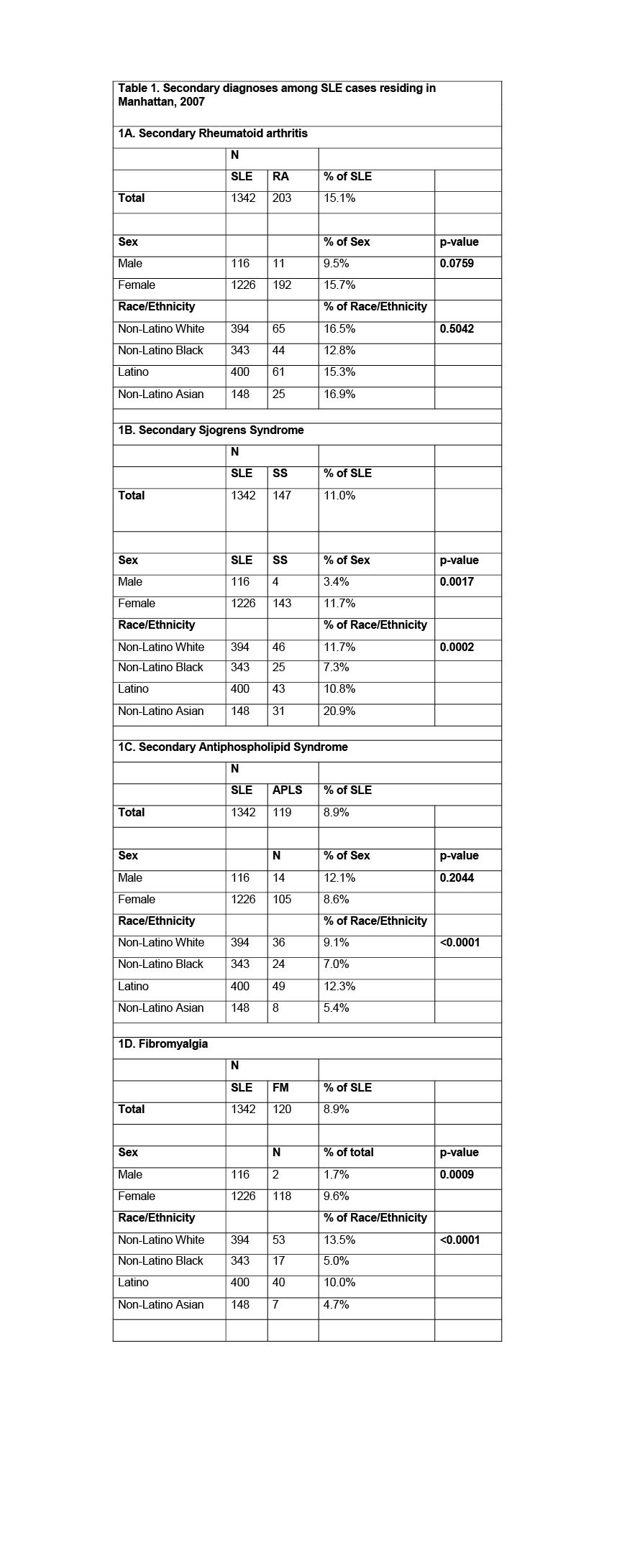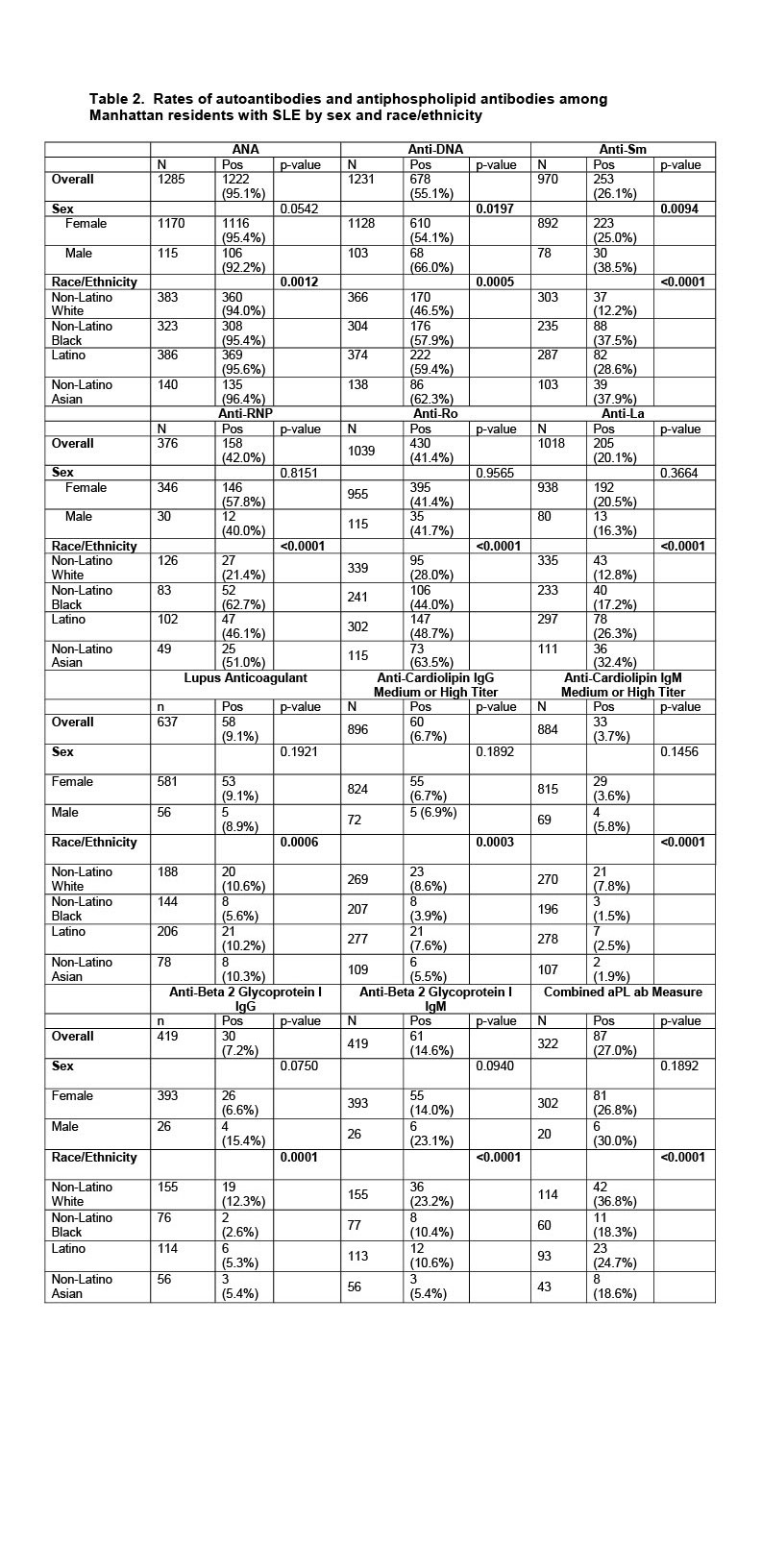Session Information
Date: Sunday, November 13, 2022
Title: SLE – Diagnosis, Manifestations, and Outcomes Poster II: Manifestations
Session Type: Poster Session C
Session Time: 1:00PM-3:00PM
Background/Purpose: Epidemiologic data of secondary connective tissue disease and autoantibody profiles among patients with systemic lupus erythematosus (SLE) remains limited for racial/ethnic populations in the United States (US). The Manhattan Lupus Surveillance Program (MLSP), a population-based retrospective registry of cases of SLE among Manhattan residents, was used to further investigate the rates of secondary diagnoses of Rheumatoid arthritis (RA), Sjögren’s Syndrome (SS), Antiphospholipid Syndrome (APLS) and Fibromyalgia (FM) in patients with prevalent SLE in 2007. In addition, we evaluated the prevalence of autoantibodies in SLE patients across sex and racial/ethnic groups.
Methods: Prevalent SLE cases had to fulfill at least one of the 3 following classification criteria 1) 1997 ACR, 2) Systemic Lupus International Collaborating Clinics (SLICC), or 3) EULAR/ACR criteria. Secondary connective tissue diseases were defined using modified criteria for RA (Rheumatoid factor positive and arthritis), SS (anti-SSA/Ro positive and evidence of keratoconjunctivitis sicca and/or xerostomia), and APLS (antiphospholipid antibody positive and evidence of a clot). FM was defined as carrying a secondary diagnosis of FM. Autoantibodies were counted if they were known to be evaluated by physician documentation or by laboratory results. Equivocal results were counted as negative. Lupus anticoagulant was only counted if both the screen and confirmatory test was positive. Anti-cardiolipin IgG and IgM were only considered positive if medium or high titer. Anti-beta 2 glycoprotein I IgG and IgM were considered positive by lab results with equivocal or borderline results considered negative. The percentage of SLE cases with each outcome and autoantibody seropositivity were calculated for sex and racial/ethnic group. Univariate differences were evaluated using chi-square tests or Fisher’s exact tests when necessary. For differences by race/ethnicity, comparisons excluded cases categorized as non-Latino other.
Results: 1,342 patients fulfilled a prevalent SLE classification criteria, Table 1. Of those 203 (15.1%) met our criteria for secondary RA, 147 (11.0%) met our criteria for secondary SS, 119 (8.9%) met our criteria for APLS, and 120 (8.9%) carried a secondary diagnosis of FM, Table 1. The distribution of cases meeting criteria differed by race/ethnicity for SS (p=0.0002), APLS (p=< 0.0001) and FM (p=< 0.0001) but not RA (p=0.5042), Table 1. Cases meeting criteria for SS and FM also differed by sex (p=.0017 and p=.0009, respectively), Table 1. The distribution of evidence for autoantibody seropositivity differed by race/ethnicity for all autoantibodies we evaluated (p< 0.05 for all), Table 2. Distribution of autoantibodies only differed by sex for anti-DNA (p=0.0197) and anti-Sm (p=0.0094).
Conclusion: Data from the MLSP revealed disparities among Manhattan SLE patients in prevalence of secondary connective tissue disease and autoantibody profiles by race/ethnicity. Understanding these differences in clinical phenotypes among minority patients is critical to alleviating the existing undue burden that SLE places on these populations.
To cite this abstract in AMA style:
Denvir B, Carlucci P, Buyon J, Belmont H, Corbitt K, Sahl S, Salmon J, Askanase A, Bathon J, Geraldino-Pardilla L, Ali Y, Ginzler E, Putterman C, Gordon C, Parton H, Izmirly P. Prevalence of Secondary Connective Tissue Diseases and Autoantibodies Among Racial and Ethnic Groups in Systemic Lupus Erythematosus Patients in the Manhattan Lupus Surveillance Program [abstract]. Arthritis Rheumatol. 2022; 74 (suppl 9). https://acrabstracts.org/abstract/prevalence-of-secondary-connective-tissue-diseases-and-autoantibodies-among-racial-and-ethnic-groups-in-systemic-lupus-erythematosus-patients-in-the-manhattan-lupus-surveillance-program/. Accessed .« Back to ACR Convergence 2022
ACR Meeting Abstracts - https://acrabstracts.org/abstract/prevalence-of-secondary-connective-tissue-diseases-and-autoantibodies-among-racial-and-ethnic-groups-in-systemic-lupus-erythematosus-patients-in-the-manhattan-lupus-surveillance-program/


